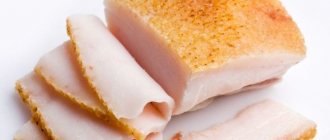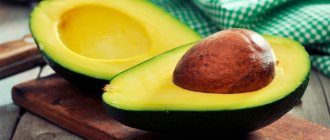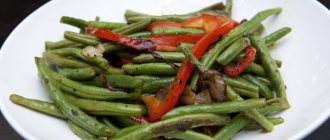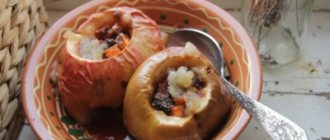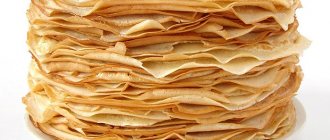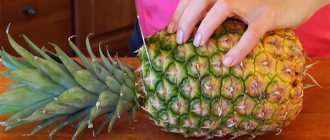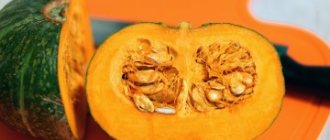Sample menu for a nursing mother in the first month
Even with all the prohibitions and restrictions, nutrition after childbirth for nursing mothers should be varied.
There are many healthy and healthy dishes that not only nourish the mother’s body, but also improve the lactation process. The table below shows an approximate menu for a nursing mother in the first month. Porridge Millet, pearl barley, barley, rice and buckwheat in water or water with milk 1 to 1 Pasta Boiled without spices and additives Vegetables Cauliflower and broccoli, zucchini and pumpkin, potatoes and herbs (parsley, lettuce, dill), green peas (not canned!); with caution - carrots Meat Rabbit, chicken or turkey, veal, beef tongue Dairy and fermented milk products Fermented milk drinks without sugar and additives, low-fat cottage cheese and cheese, sour cream
Fruits and berries Baked apples, bananas and pears, white currants, gooseberries and lingonberries Dried fruits Dried pears and apples, soft dried apricots, prunes Drinks Green tea, weak black tea, water, freshly squeezed juices from apples and pears, half diluted with water, compotes and fruit drinks
Menu for a week while breastfeeding
Knowing what foods mothers can eat, a woman will be able to independently create a menu during breastfeeding - the first month is the most important in this regard.
It is important to completely exclude foods that are highly allergenic. It is required to be attentive to the condition of the newborn, observing the reaction of his body to the foods consumed by the mother
A sample menu for the week can be found in the table.
| Days of the week | Breakfast | ||
| Monday | Buckwheat porridge with butter, fresh vegetable salad, two slices of stale bread, green tea | Boiled cauliflower and boiled lean meat | Dumplings with cottage cheese, low-fat sour cream, children's choice of fruit puree |
| Tuesday | Oatmeal with butter, a glass of kefir, biscuits | Soup with meatballs from ground beef, vegetarian pilaf | Boiled rice with vegetables and boiled breast |
| Butter rice, butter and cheese sandwich | Chicken meatballs, vegetable soup, beet salad, glass of fermented baked milk | Rabbit with vegetable stew, biscuits, fermented baked milk | |
| Thursday | Vegetable stew, black bread with butter and cheese, boiled eggs, fermented baked milk | Vegetable salad, rabbit stew, cottage cheese casserole with cherries | Boiled pasta with lean boiled meat |
| Friday | Mashed potatoes with lean boiled meat, fresh vegetable salad, natural yogurt and banana | Beetroot salad, vegetable cream soup, boiled eggs | Rabbit ragout, buckwheat porridge and a few slices of pickled cucumber |
| Saturday | Oatmeal with butter and baked apples | Borscht with lean chicken or turkey meat | Cheesecakes, Olivier with sour cream and fresh vegetable salad |
| Sunday | Porridge with butter of your choice, steamed cutlet, sandwich with butter and cheese | Vegetable cream soup, lean meat meatballs, kefir and biscuits | Fresh vegetable salad, boiled chicken fillet, buckwheat porridge |
Menu for every day while breastfeeding
Breastfeeding begins while the mother is in the maternity hospital, so the woman takes food that is given in the canteen. After being discharged from the maternity hospital, the mother makes her own menu.
An example is the following:
- first breakfast – weak black tea, 1-2 crackers;
- second breakfast – buckwheat porridge with water, celery root salad with sour cream;
- lunch – light soup with chicken or beef broth, boiled broccoli with olive oil;
- afternoon snack - children's fruit puree;
- dinner – lazy dumplings with sour cream, baked apples.
Nutrition for a nursing vegetarian mother in the first month
A vegetarian diet during breastfeeding in the first month is not advisable, but doctors allow this dietary option. According to studies conducted by WHO, a nursing mother needs to consume 56 g of protein per day. For women who adhere to a vegetarian diet, the source of protein is cereals, legumes, and nuts. 100 g of bread provides an additional 7 g of protein. Taking this into account, a menu for a nursing vegetarian mother in the first month can be easily compiled.
Healthy pork liver dishes
In general, pork liver is much tougher than veal liver, so to cook it tasty and healthy you need to know a special recipe.
To prepare a dish healthy for nursing mothers, you will need four hundred grams of pork liver, one large onion, a clove of garlic, a glass of sour cream, one teaspoon each of mustard and flour, one hundred grams of milk, salt and vegetable oil. First, remove the film from the liver. If you are not good at this, then sprinkle it with lemon juice, then the film will be removed in the blink of an eye. Cut the liver into small pieces at your discretion. Take a deep bowl, place the chopped liver there and fill it with milk for thirty minutes. This will soften the pork liver. When it gets wet, drain the milk and squeeze it out.
Place the frying pan on the fire and heat it thoroughly with the vegetable oil. Fry finely chopped onion, add liver, lightly brown for ten minutes.
Whisk mustard, flour and sour cream in a bowl. Pour the resulting slurry into a frying pan and simmer the liver for twenty minutes. Add spices and herbs to the finished dish and simmer for another five minutes. Remember to stir occasionally to prevent anything from burning. If the liver is still hard and the liquid has evaporated, then halfway through cooking you can add a glass of water.
The end result should be a pretty tasty dish, somewhat similar to goulash, served with a side dish.
You can also cook steamed liver cutlets, which turn out simply delicious and bring healthy satiety to the nursing mother, as well as complete satisfaction from the taste of this dish.
To prepare the cutlets, mince four hundred grams of pork liver, two onions, and a clove of garlic. Add six tablespoons of semolina, a little soda, pepper and salt to the resulting minced meat. To prevent the resulting “dough” from spreading, add breadcrumbs. Form cutlets and cook them in a double boiler. This dish will add some zest to a nursing mother’s menu, which is crowded with dietary products.
How to properly consume lard while breastfeeding
A nursing mother can eat lard no more than 2-3 times a week
Any product, even the healthiest one, can be harmful if consumed in unlimited quantities.
It is important to note that lard is a very fatty and high-calorie product, which means that, unfortunately, it cannot be included in the daily menu of a nursing mother. Mommies can pamper themselves with this product only 2-3 times a week, eating several small pieces (up to 30 grams)
If a woman has diseases of the liver or gastrointestinal tract, especially cholecystitis and pancreatitis, it is advisable to consult a doctor, since due to the pronounced choleretic effect and fat content, lard can provoke an exacerbation of these diseases. It is advisable to use it with cereals, salads and other vegetable dishes.
Which method of cooking lard is suitable for a nursing mother?
Lard is prepared in cooking in different ways - smoked, baked, fried, boiled, salted. A heat-treated product loses all its beneficial properties and can even cause harm to the body. For example, during smoking or frying, harmful carcinogens are formed in pork fat, which negatively affect the functioning of the liver, kidneys and the body as a whole. During lactation, mommy should give preference only to salted lard. It is advisable to prepare it yourself at home and when salting, use only salt, abandoning the abundance of seasonings, spices and garlic.
Options for salting lard recommended during lactation
There are various methods of salting, but not all are suitable for a nursing mother. Let's look at some options.
Salting lard using the wet method involves preparing a brine - 1–1.5 cups of salt per 1 liter of water. First wash the lard and cut it into pieces. Then we put it in a saucepan, fill it with brine and put it in the refrigerator. After 2-3 days you can take a sample; usually this time is enough for salting. The finished product is stored in the refrigerator for 2-3 weeks. You can transfer the finished pieces into a dry container, or you can leave them in brine; this will not affect the quality of the lard, it takes as much salt as it needs.
The easiest way is dry salting. Wash the lard, cut it into pieces and generously grease with coarse salt. Place tightly in a saucepan or any convenient container; you can also sprinkle salt on top. Place in the refrigerator for 2-3 days and then try. If the pieces are large and poorly salted, leave them for another day or two. In the future, such lard is also stored in the refrigerator for 2-3 weeks, and in the freezer for more than a month.
Harm from pork
Pork is a very fatty and high-calorie food. In addition, it differs from other types of meat by the presence of a thick layer of subcutaneous fat and a high content of lipids and cholesterol. This is dangerous for human health, since consumption of such substances subsequently leads to heart attacks and strokes, and the development of atherosclerosis.
Pork negatively affects the functioning of the liver and kidneys. And high histamine content causes some inflammatory processes, skin and gallbladder diseases. Pork meat should not be consumed if you have problems with the gastrointestinal tract or kidney pathologies.
Pork can cause constipation in a baby or, conversely, diarrhea, bloating and colic. Poor quality meat becomes very dangerous for the baby and mother, it causes severe intoxication and can cause infection in the body
Therefore, if you decide to cook pork, it is important to choose high-quality and fresh meat
How to choose and what to pay attention to?
The first thing you should pay attention to is the color and smell of the meat. The smell should be pleasant, without impurities, and the color should be bright red or burgundy
Darker shades indicate an older animal.
When you press on the piece, the dent springs back and returns to its previous shape.
The edges of the cut piece are moist, without mucus. If you choose liver, its color is red-brown, its smell is sweetish, and there is a white film on top.
Dietary beef will help you quickly satisfy your hunger; if you follow the precautions for its consumption, it will only bring benefits and will not cause negative consequences. There are a number of rules for consuming this type of meat for a nursing mother.
- Careful heat treatment. It is forbidden to eat steaks and beefsteaks that are rare and medium rare.
- You can only eat boiled, stewed or baked beef. You need to cook without spices, hot seasonings and sauces.
- On the third day after giving birth, a nursing mother can eat beef broth, and then soup based on it.
- A week after giving birth, you can already eat boiled meat. First, a small piece (be sure to monitor the baby’s reaction).
- After six months, it is possible to introduce grilled meat into the diet if there are no consequences for the baby.
- The amount of meat per day is 150 grams. After discharge, we limit ourselves to 40-60 grams. Overeating can lead to colic in your baby.
- You should choose only young and always fresh meat for food, not frozen. Usually this is tenderloin - it is rich in vitamins and microelements. Beef liver is consumed in the diet only after three months from birth, in the amount of 60-50 grams and no more than twice a week. Minced meat is prepared independently and from fresh meat; you can use it to make steamed cutlets and dumplings (necessarily without spices).
- Before cooking, the meat is soaked in water for about an hour; when preparing the broth, the water is changed five minutes after the start of cooking. Baking beef takes forty or sixty minutes, cooking - about 2 hours.
The new product is being introduced into the nursing menu gradually
, the baby’s reaction is definitely observed - so that there are no rashes, bloating, or abnormal bowel movements. After giving birth, three to four days later, you can drink about 200 grams of broth, but the first portion is no more than 50 grams.
Nursing mothers are very attentive to their diet, since the well-being of the infant depends on it. A woman’s diet should contain all the beneficial substances that come from food of both plant and animal origin. As a source of protein, a nursing mother may be offered to consume veal or beef.
Beef is the meat of cows and bulls of different ages. It comes in three varieties:
- highest - breastbone, back, sirloin, sirloin, rump, rump;
- first - flank, shoulder blade, shoulder part;
- the second - shanks at once.
The taste of beef directly depends on the age and method of nutrition of the animal. It can be either juicy and tender, or rough and dry. Also, the characteristics of meat are negatively affected by the stress that the animal experienced during slaughter. A high-quality product has a fibrous structure, rich red color and a pleasant smell. When pressed, a hole is formed that quickly disappears.
The meat of a young calf, whose age does not exceed 5 months, is especially valued. Its color is soft pink, and its structure is extremely delicate. Veal has thin layers of fat, so minimal processing is required when preparing it. Otherwise it will be too tough.
What is goulash
Goulash was first invented by shepherds; it was cooked over a fire in a large cauldron, where the meat was first fried and then stewed until tender along with vegetables.
Goulash is a thick soup originally from Hungary, where it is still served as a first course. It was especially popular with shepherds, who cooked it in cauldrons over a fire. During the cooking process, small pieces of beef or veal were fried along with smoked bacon, onions, paprika and potatoes, then covered with water and simmered until the water turned into a thick sauce.
In Russia, goulash was the signature dish of catering establishments and was classified as a second course served with a side dish. It was called a stew made from boneless meat, prepared in two steps:
- roasting meat;
- stewing in a small amount of water with the addition of tomato paste or fresh tomatoes.
Currently, the recipe for making goulash involves frying meat in lard, to which vegetables are added, and then flour. After this, tomatoes or sauce, as well as hot water, are added to the resulting mass. The result is a tasty and satisfying dish that goes well with any side dish - potatoes, pasta or rice.
Authentic Hungarian goulash
How to cook stewed pork for a nursing mother
Stewed potatoes are the most delicious in the world, according to many. But it didn’t work out like my mother did. Maybe it will come over the years, and How to cook stewed potatoes with pork and... How can a nursing mother lose weight after childbirth? How can a nursing mother lose weight after childbirth? a lot of animal fats - do not eat grease, lard, fatty pork, frost.
In order to How to cook cabbage stewed with mushrooms. 1. Preheat the oven to C. 2. Add the shredded pork and brown until the fat has rendered. How to choose and cook pork for a nursing mother. To ensure that eating meat does not harm either the mother or the baby, it is worthwhile when choosing it.
It is not recommended for a nursing mother to consume pork for several reasons, such as histamine. Is it possible for a nursing mother to eat pork?
Meat is an integral part of the diet during lactation; absolutely all nutritionists agree that it should definitely be present on the menu of a young mother. But here the question immediately arises: is a product such as pork allowed to be consumed while breastfeeding?
Whether this meat poses any danger to the health of mother and baby, or whether beneficial properties still prevail in it, we will find out in the course of our article today.
The answer to this is unequivocal - yes, however, this particular type of meat is quite specific, and therefore this issue requires a more detailed consideration.
Why pediatricians insist that women not eat pork during lactation
These microelements are necessary for the maintenance and development of brain function, as well as strengthening bone tissue. In the first year of a baby’s life, its most intensive growth occurs, and therefore the need for these compounds is increased.
Wild goose with prunes recipe
Pork contains omega-3 fatty acids and B vitamins. The beneficial qualities of these substances for human health have long been proven, since they are involved in many vital processes.
Povarenok ru recipes for dough for pies in a bread machine
They are especially necessary for growing children. However, this meat also has a number of harmful qualities, and they are quite serious.
Sample menu for the day:
It is because of these features that pork is so often classified as undesirable and even harmful products, here are the main ones:. As you already understand, the most important condition when eating pork is choosing it correctly.
Pumpkin with chicken in the oven recipe with photos
Only a fresh and high-quality product from a large, trusted manufacturer can guarantee the absence of the dangerous properties described above
But even a completely pure product can cause an undesirable reaction in a child, and therefore it is important to know how and in what quantity you should introduce pork into your diet.
It is best to postpone the introduction of such meat until the child reaches three months of age - by this time his digestive system will already be ready to digest particles of the new product received with his mother’s milk.
Harmful properties of pork
So, during the course of the article, we found out that although pork is allowed during breastfeeding, it must be consumed with extreme caution. Quite often this meat contains harmful substances that do not disappear during heat treatment.
Rules of use
To prevent a delicious pork dish from becoming the culprit of banal poisoning and causing other damage, nutritionists have developed several useful recommendations specifically for nursing mothers. We present them here in full:
- Experts recommend starting to introduce pork into the diet only after the baby is three months old from birth.
- When choosing meat products in this category, you should give preference to pieces with little fat. Its share should not exceed 10% of the total mass of the product.
- It is better to buy fresh rather than frozen meat. When choosing, be sure to do the following test: lightly press on the surface of the meat, if after this there is no dent left on the surface, then the product is of good quality.
- Color matters too. Quality fresh pork will have a pale pinkish hue.
- Pork must undergo long-term heat treatment before reaching the table of a nursing mother. The best option for preparing dishes is the steam method or baking in the oven. It is allowed to stew pork. Any other methods, including cooking kebabs and grilled meat, are unacceptable in the diet of a woman during lactation.
- It is better to eat pork dishes in the first half of the day.
- The first dish should be meat broth. It should not be too concentrated, so it can be diluted a little with boiled water.
- When the baby gets used to the changes in the mother’s menu, you can introduce dishes made from full-fledged meat. The initial portion should not exceed 50 grams. This dose will gradually increase, but it should not exceed 150 g.
- You can diversify the menu with pork no more than two, or at most three times a week.
- And lastly: a nursing mother must remember the risks associated with overeating. Only compliance with the measure will make meat dishes truly healthy.
Important point!
When breastfeeding, the possibility of eating half-raw meat is not considered at all, because it is very dangerous.
Products useful for breastfeeding
Rice, corn, buckwheat, like all cereals, are the basis of a healthy diet, as they contain slow carbohydrates that are beneficial to the body and create a feeling of fullness for a long time
But in the case of grain crops (wheat, rye, barley), caution should be exercised, as they are potentially dangerous products due to the risk of gluten allergies. Low-fat fermented milk products without food additives - kefir, fermented baked milk, cottage cheese, yogurt - should be present in the diet every day, as they contain calcium in an easily digestible form. It is not recommended to consume fresh, unsoured milk due to the risk of allergies. Vegetables and fruits contribute to the normal functioning of the intestines due to fiber, contain easily digestible sugars (glucose and fructose), vitamins, microelements and antioxidants
But only those vegetables and fruits that grow where the mother and child live can be considered healthy and safe. Exotic foods carry an increased risk of allergic reactions. You need to pay close attention to red vegetables and fruits, as they are on the list of potentially dangerous products. Of all types of meat, poultry and fish are the most beneficial. But if you or your child have allergic reactions to these products, then you can eat other lean meats. Particular attention should be paid to sea fish, as it contains polyunsaturated fatty acids that are not found in other foods.
Useful qualities of pork
Pork holds the record for fat and protein content. These components have a good ability - they warm the body, which is especially useful during cold periods. As a food product, pork has a high energy value. Even a small portion of meat eaten at the table stimulates tone and gives strength. In addition, with regular consumption of pork, the following beneficial transformations occur in the body:
hemoglobin levels stabilize; the condition of the vascular walls improves, which has a beneficial effect on blood circulation; the contractility of the heart muscle is normalized; bone tissue is strengthened, and this is especially important for the growing baby’s body; hormonal activity is regulated; the capabilities of the immune system increase.
Studies have shown that pork helps cope with depression and even improves mood. In addition, the high content of proteins and vitamins from group “B” has a beneficial effect on the structure of hair and nails. Therefore, pork dishes will help a woman to maintain her beauty to some extent. Vitamins of this group contribute to the rapid recovery of women after childbirth.
How to salt lard yourself
This product can be prepared in various ways. If you salt the lard using the dry method, it will be ready in about 3 weeks. But the shelf life of such a product will not exceed 1 month. Lard can also be prepared in brine. The process is quite labor-intensive, but the shelf life of the product increases to 1 year. If you prepare the product by boiling or hot salting, then all the harmful substances in the lard are destroyed. As a result, you do not risk encountering dangerous infections or poisoning. Animal meat is often susceptible to this. If you are breastfeeding, then the option with boiled lard is the most suitable and safe. Chop the product into pieces no more than 3 cm thick. Prepare a decoction of onion peels. Place lard in boiling water. The husk acts as a dye, nothing more. Add salt to the broth to taste, simmer the product for about 15-20 minutes. It is worth noting that the brine should completely cover the pieces of lard. After this, rub the product with allspice and salt. Place the preparation in the refrigerator. The shelf life of this lard is approximately six months. If you don't want to bother too much, you can take the easier route. Chop the lard into small pieces, rub with spices and place in a plastic bag. Leave the product at room temperature for 12-15 hours. After this, transfer the product to the freezer for 2 days. Keep in mind that lard prepared in this way must be eaten in the first 4 weeks
It is important to know that it is not recommended to rub the product with garlic if you are breastfeeding your baby.
Rules for storing meat products
If store-bought meat is not used immediately, it is advisable to use it in the next two days. The product can be stored in the refrigerator on the top shelf for the entire specified period. If the storage time increases, then you need to place the meat in the freezer. There it can be stored for no more than three months. Moreover, defrosting and then freezing meat again is strictly prohibited.
Before placing it in a low-temperature chamber, the meat must be thoroughly cleaned of debris and the packaging removed. Under no circumstances should it be washed. Pork is washed before cooking. For short-term storage, it is wise to use a container with a lid to prevent microflora and air from reaching the surface of the product. Alternatively, you can wrap a piece of meat in cling film.
By following these simple recommendations, all risks will be minimized and the benefits from the product will be maximized.
Rules for following a hypoallergenic diet
In addition to foods that are highly likely to cause allergies, there are many less pronounced allergens.
This intermediate category between allergens and hypoallergenic products includes organ meats, potatoes and legumes, green bell peppers, apricots, watermelons, currants and cranberries, biscuits and grain breads.
They need to be introduced into the diet little by little at first, and the child’s reaction should be monitored.
Eat what grows in your area.
Until the baby is 3 months old, the mother should not consume even potential allergens of moderate activity. The rules for expanding the diet of a nursing mother are in many ways similar to the rules for introducing complementary foods. A good habit is to keep a food diary, which reflects the mother’s diet, especially innovations in it, and the baby’s reaction.
You should introduce no more than two new products that can cause allergies per month, waiting 2 weeks for a possible reaction. In terms of allergic reactions, the safest fruits are those growing in your area.
When should you not breastfeed? Doctors prohibit breastfeeding a child after drinking alcohol. You cannot feed until the mother is completely sober, although the critical concentration of alcohol in the milk will be 30 minutes after drinking. Only after the liver has processed the alcohol, after about two hours, can the baby be put to the breast.
The benefits of lard
- Due to its nutritional value, the presented product is included in the menu to maintain strength and energy exchange. Lard saturates and prolongs the feeling of fullness for a long time. It contains many vitamins that are beneficial to humans. In particular, we are talking about tocopherol, retinol, vitamin D. They are important for maintaining the beauty and integrity of bones.
- The contained tocopherol (vitamin E) is responsible for the normal hormonal environment, and also reduces the levels of cholesterol plaques in the cavity of the blood channels. It is a mistake to believe that lard is fatty; it will not harm the figure if taken in moderation. On the contrary, calories are burned by increasing metabolic processes.
- The presented raw materials have one excellent ability - to bind radionuclides and remove them from the body. It is useful for cancer prevention. The product also cleanses the organs of toxic substances and heavy metal salts. The product contains arachidic acid, an important component of the hematopoietic and digestive systems.
- Lard is valued by nursing mothers due to the presence of vitamin D. This substance is necessary for bone tissue to maintain integrity. Infants need vitamin D for the formation of the musculoskeletal system, the prevention and treatment of rickets. According to statistics, more than 30% of children after birth face a deficiency of this vitamin. Eating lard, potatoes, oatmeal, fish oil, and seafood will help replenish it.
- Many people mistakenly believe that lard is a source of mass cholesterol. But in fact, it contains less cholesterol than the notorious butter. Moreover, when taken in doses, the blood channels will be cleared of harmful substances, and the production of red blood cells will improve.
Pork meat and lard are on the young mother's menu. Pork may or may not be consumed while breastfeeding. Recipes
An important part of a woman’s diet during lactation is meat. However, not every protein product is suitable for consumption.
Pork is not very suitable for this when breastfeeding. Doctors recommend using lean meats in the menu: beef, poultry, veal, rabbit meat.
After giving birth, a young mother is offered to eat non-rich beef broth to maintain strength. Subsequently, the diet of a nursing woman will include first courses of vegetables, baked or stewed meat. But often mothers are concerned about the benefits of pork dishes and the possibility of consuming lard.
Lean beef broth will perfectly strengthen the strength of a woman who has given birth.
Beneficial features
The most favorable time for eating pork, rich in fats and proteins, is winter. Meat supplies the body with energy, warming and toning. The baby's skeletal system is formed thanks to proper nutrition. Consumption of a protein product affects:
- strengthening vitality;
- functioning of the cardiac and vascular systems;
- complete formation of skeletal bones;
- strengthening the skeletal system;
- emotional condition;
- normalization of hormonal levels;
- formation of blood cells in a newborn;
- hemoglobin level, elimination of migraines and dizziness.
B vitamins coming from meat foods will restore hormonal levels and body function in the postpartum period. Adequate nutrition will strengthen a woman’s strength and have a beneficial effect on the condition of her hair, skin and nails.
Use during breastfeeding
- Consumption of pork meat begins from the fourth month of a child’s life;
- Remove as much fat as possible or choose low-fat parts of the carcass.
- Use the cooking method - boiling, stewing or baking (at least 1.5 hours).
- Steamed pork dishes diversify the menu when breastfeeding.
- It is worth temporarily giving up cooking kebabs, grilling and frying meat.
- Offal (tongue and liver) have a low percentage of fat. Dishes prepared from them can be used in mother’s diet.
- The best time to eat pork dishes is before 14:00.
- Accustoming your baby to the product should start with using weak meat broth.
After two days, if there are no disturbances in the baby’s intestines, it is allowed to eat a piece (50 grams) of boiled meat. It is possible to diversify your diet with vegetable soups, which are allowed during lactation. - If an allergy occurs, you should give up meat products for 1-1.5 months, then return to complementary foods.
- An important point is moderation (once a week, 120 grams
per day), in the absence of allergic reactions. - Before cooking, pork should be soaked, rinsed, and excess fatty tissue removed.
The benefits of pork
Pork is rich in protein, which is the basis for the construction of new cells and growth of the child. The composition contains B vitamins and choline. Thanks to these components, the level of cholesterol in the blood is reduced, immunity is increased, the functioning of the nervous system is normalized, metabolism is enhanced, the skin and mucous membranes are protected from the invasion of infection.
Pork contains vitamins A, D, E, essential amino acids and minerals: iron, potassium, phosphorus, magnesium, sodium. 100 g of pork contains 24 g of protein, 11 g of fat, and the calorie content of lean pork is 160 kcal.
Due to the content of vitamins and minerals, pork benefits the body:
- efficiency increases, vital energy increases;
- has a beneficial effect on the nervous system, helps relieve fatigue;
- has a positive effect on the activity of the circulatory system;
- allows you to replenish milk deficiency and enhance lactation in women during breastfeeding;
- helps strengthen bones;
- strengthens the immune system.
Can it be in a child’s diet?
Doctors' opinions on this issue are also divided, but most pediatricians are still inclined to believe that lard can be gradually introduced into a child's diet, since it contains the same saturated fats as mother's milk. By feeding on breast milk, the baby gradually adapts to the fats that are contained in many foods that he will have to eat later.
At what age should it be included in the diet?
While the baby is still feeding exclusively on mother's milk, naturally, there can be no talk of any fat, like other products - the body simply cannot digest them. But as soon as the child begins to gradually try other foods, it will be possible to give him lard in small quantities.
Ideally, lard can be included in a child’s diet from the age of one and a half years. It is recommended to melt fresh lard and pour it over porridge and baby purees - it will be tastier, and you won’t have to chew the lard, and you won’t have to worry about the baby becoming infected with helminths - if they were in the product, after heat treatment they will not be present. will remain.
How is it useful?
Even for a child’s body, lard can be of great benefit, which is due to its rich composition. There are several compelling arguments in favor of periodic consumption of lard by children.
Removes toxins from the body and increases vitality, which is especially important for children born in an insufficiently clean ecological region. A large amount of vitamins in lard can replace even expensive children's supplements from pharmacies. Moreover, vitamins from lard are much better absorbed by the child’s body. Lard helps fight bacteria and viruses, promotes rapid healing of wounds and scratches in active children
And consuming lard from December to March helps maintain good immunity in the child. Homemade lard restores the functioning of the gastrointestinal tract, normalizes hormonal activity and processes cholesterol.
It is better to give preference to lard from your own farm or buy the product from trusted people, this way you can reduce the risk of infection with parasites to a minimum.
The benefits and harms of goulash
The traditional recipe calls for frying meat for goulash in lard, which undoubtedly will not benefit the body. However, in the old days, its main consumers were shepherds who had to walk a lot. For them, fatty foods were a source of energy.
It is better for nursing mothers not to use lard in making goulash.
Goulash with lard is contraindicated for people suffering from atherosclerosis and obesity. It should not be used for cholecystitis and liver diseases. An obstacle to eating such a dish is the presence of pancreatitis - inflammation of the pancreas.
For nursing mothers, it is advisable to modify the recipe for traditional goulash by replacing lard with vegetable oil. Pork should not be used as the main component, which, although it contains less cholesterol, is significantly higher in fat content than other types of meat. After childbirth, the body recovers, and fatty foods can cause a reaction in the stomach and intestines.
Eating meat, which is the main component of goulash, increases the number of red blood cells in the blood, helping to increase hemoglobin levels. Therefore, goulash, regardless of the type of meat, is useful for anemia. Tomato paste and tomatoes contain lycopene, an antioxidant that prevents the development of cancer cells and has a positive effect on the cardiovascular system.
Types of meat
What you can breastfeed and what you should avoid:
- Turkey is considered one of the safest meat products. Turkey is easily digestible and helps the baby, along with mother’s milk, receive many useful elements that are needed for the formation of the skeletal system. It contains a low percentage of cholesterol, without clogging the blood vessels of the body, which contributes to the proper functioning of the gastrointestinal tract;
- Chicken's meat.
It is considered a dietary product. It contains many useful vitamins and microelements. The white meat of this bird helps a woman recover as quickly as possible after childbirth. But now manufacturers have begun to add antibiotics to chicken meat to preserve this by-product for a longer period of time. Therefore, it is better to eat homemade chicken, from your own farm;
- Goose is a very healthy product when breastfeeding. It contains a sufficient amount of vitamin B, C, A, as well as various amino acids. But before buying a goose, it is worth considering that 50% of the carcass is fat, so after cooking, the mother needs to choose the leanest pieces of the dish;
- Duck while breastfeeding. Duck meat is harder for the body to digest, so you need to choose lean duck. The fact is that an excess amount of fat in the mother’s food increases the percentage of fat content in milk, thereby leading to gastrointestinal upset in the baby. Although some mothers, on the contrary, are puzzled by how to increase the fat content of breast milk>>>;
- Rabbit meat, like turkey, is recommended for mothers with guards. Rabbit meat is well digestible, is dietary, and contains all the necessary vitamins and microelements that women and children need;
- Pork during breastfeeding.
It is very useful for the body, but many doctors do not advise using it often during guarding. It's all about the fat content, so if mom wants to enjoy delicious pork, it's better to opt for lean pieces;
- It is better to introduce lamb during breastfeeding 4 months after birth (you can learn about what a baby can already do during this period from the article What should a baby be able to do at 4 months?>>>), when the baby’s tummy is already strong, it is the same as Pork is considered fatty. And, in addition to useful components, it contains an increased amount of cholesterol;
- Smoked meat during breastfeeding. Different types of smoked meats add their own flavor to the milk, which means that the baby may abruptly refuse mother’s milk. And now special means for quick smoking are often used, which can cause poisoning in mother and baby;
- Crab meat during breastfeeding. If you correctly introduce crab products into your diet, there are no special prohibitions on its use. Since crab contains a large amount of minerals, as well as valuable protein. But don't confuse crab meat with crab sticks. It’s better to completely abandon them; your body will not receive anything other than dye, flavoring, soy, and preservatives.
From poultry, it is better to opt for turkey or domestic chicken. Choose low-fat varieties of goose and duck and try not to eat them too often. When cooking poultry, remove the skin from it, as it is quite an allergen for your baby.
From animal meat, it is better to choose rabbit. Pork and lamb are also possible, but not very fatty. But it is better to avoid beef when breastfeeding and store-bought chicken; beef is considered allergenic, and store-bought chicken often contains an antibiotic.
- Diet of a nursing mother
- Can a nursing mother have dumplings?
- Can a nursing mother eat borscht?
Meat broth - as the basis of soup
During lactation you should not eat any meat; you can prepare soups using:
- beef. This meat differs from pork in its lower fat content; ideally, you should eat veal - the meat is fresh and young.
- turkey meat. Fillet is considered the most dietary meat ingredient.
- rabbit meat. In addition to the lowest amount of calories, rabbit meat is one of the hypoallergenic products.
- chicken breast. It's not as fatty as chicken legs. The main thing is that chicken meat does not cause allergies in the newborn.
Meat broth is the main component of soups that can be consumed in the first month after childbirth.
Delicious and nutritious soups with meat broth can be prepared according to the following recipes:
Soup with chicken meatballs or turkey meat
To prepare you will need:
- clean drinking water - 2 liters;
- minced fillet - 300 grams;
- potatoes - 3 pieces;
- carrots - 1 piece;
- rice - 100 grams;
- egg - 1 piece;
- salt.
Cook the rice, add the egg and a little salt to the minced meat, and make meatballs. Boil water, add meatballs, chopped vegetables. Boil for 20 minutes until tender, add rice, bring to a boil.
Sorrel soup with beef broth
To prepare you will need:
- clean drinking water - 2 liters;
- beef - 300 grams;
- potatoes - 3 pieces;
- sorrel leaves - 300 grams;
- egg - 3 pieces;
- salt;
- sour cream - 1 tablespoon.
Boil the meat for quite a long time (about an hour and a half), strain the broth, add finely chopped potatoes. Add the disassembled meat, bring to a boil, simmer for 15 minutes. Then add finely chopped sorrel. When boiling, add the eggs - introduce them into the soup in a small stream, stirring constantly. Cook until tender - about 5 minutes. When serving, top with sour cream.
Puree soup with added rabbit
To prepare you will need:
- rabbit meat - 300 grams;
- flour - two tablespoons;
- egg - 2 pieces;
- cream - half a glass;
- butter - one teaspoon;
- vegetable oil - two tablespoons;
Prepare rabbit broth, disassemble the carcass and separate the meat. Stir together with a small amount of broth and puree with a blender. Separately mix flour with vegetable oil and fry the resulting mass. Add a little broth and simmer over low heat for about 30 minutes. Add the meat part into the prepared sauce and mix. Add butter, beat egg whites and cream in a separate bowl and pour into soup. Bring the dish to a boil and serve when ready.
Recipe for delicious and healthy meat
Any fried food - meat or vegetables - is poorly digested by the stomach and can cause a feeling of heaviness and discomfort. Since digestion of fried meat food can take quite a long time, a woman experiences not only discomfort, but also abdominal pain. The newborn will experience the same unpleasant sensations. After childbirth, a woman’s body is weakened and her immunity is lowered, so her digestive system cannot cope with processing fatty and fried meat. All fats that enter the body of a nursing mother will be transferred through her milk to the baby. After such a meal, the newborn may experience abdominal pain, colic and indigestion.
https://www.youtube.com/watch?v=7Sjgtw3L3iE
In addition, excess fat in the body leads to obesity, which leads to poor health and health problems. The baby also becomes overweight.
Kebab for a nursing mother is guaranteed to increase the load on the entire body. Those who like to pamper themselves with meat often suffer from excess weight. It contains large amounts of cholesterol and fat. These components do not carry any positive aspect of use. After such a dish, a person’s stomach is guaranteed to develop a feeling of heaviness and heartburn. After a certain period, the woman begins to feel tired.
It is very important which recipe and cooking option you are going to use. In order to completely digest a dish, the body must expend a large amount of energy.
Fat tends to settle in the stomach and stay there for a long period of time.
The child consumes almost all the food his mother eats only in processed form. The fat will certainly pass into breast milk. Because of this, the baby's risk of colic and bloating increases.
A pork dish increases the risk of obesity not only in the mother, but also in the child. This type of meat is high in calories. Lamb will also have a negative effect on the body as a whole. She's also incredibly fat.
We invite you to read: Maria Montessori Early Development Methodology
It is recommended to use chicken meat
Chicken meat has fewer calories and is easily digested by the mother's body. You can sometimes treat yourself to this version of meat.
The baby has not yet fully formed digestive system. For the first time, you are allowed to eat just a little kebab, and then carefully monitor the baby’s body’s reaction.
It is allowed to marinate meat only using the lean method. The cooking process should be done on wooden skewers. All received tools are placed in a three-liter jar and sent to a still cold oven. It will take at least one hour to cook the meat. Every woman is guaranteed to enjoy the dish, and it does not require a significant investment of time and effort in preparation.
Shish kebab should be combined with vegetables
For a tasty and healthy dish you will need the following ingredients:
- chicken breast;
- two tea spoons of sugar;
- 0.5 cups of kefir;
- two onions;
- salt and pepper to taste.
At the first stage, you need to wash the meat well and cut it into small pieces. Next, salt and pepper are added to it. The onions are grated, mixed with kefir and added to poultry meat. The mixture should sit for at least an hour. The vessel is closed with a lid and placed in the refrigerator for at least 10 hours.
This version of kebab is considered optimal for the body of mother and child, because only natural and healthy ingredients are used for marinating. Poultry meat is devoid of a large amount of fat, which complicates the functioning of the digestive system. The dish is guaranteed to please all guests and family members.
Healthy kebab
There are simple recipes for cooking chicken breast or turkey.
Chicken kebab
- Poultry shashlik.
For 1 chicken breast you need:
- 100 g 1% kefir;
- 2 onions;
- 2 tsp. Sahara;
- salt, herbs.
Wash the breast and cut into pieces, sprinkle with salt and herbs. Add grated onion and kefir, previously mixed with sugar. Place everything in a bag and leave in the refrigerator for 2 hours, after which the meat is baked on the grill in the usual way.
Shish kebab in the oven
- Shish kebab in the oven.
If you can’t barbecue, but really want to, you can cook something similar, but in the oven. To do this, the meat prepared as described above should be strung on wooden sticks, interspersed with pieces of tomatoes and eggplant. Then put everything into a 3-liter bottle and place in a cold oven. Place a wood chip on the bottom of the oven for scent. Bake the dish for an hour.
Such recipes will be harmless for a nursing mother and infant. Only approved products are used in preparation.
Fish soups
Fish is no less valuable component in the diet of a nursing woman than meat. It is customary to add low-fat fish to soups during breastfeeding. Protein-rich fish dishes should be eaten at least twice a week. The menu of a nursing mother can be supplemented with the following fish soups:
Fish soup with vegetables and barley
To prepare you will need:
- clean drinking water - 2 liters;
- white fish (pollock, hake) - 300 grams;
- potatoes - 4 pieces;
- pearl barley - 50 grams;
- olive oil - one tablespoon;
- greenery.
Boil the fish and drain the first water. Strain the second broth when ready. Add cereal, cook for another ten minutes. Add the diced potatoes and boil for another ten minutes. Then add fish pulp and oil. Serve with greens.
Pink salmon soup with cheese
To prepare you will need:
- fish (pink salmon) - 200 grams;
- carrots - 1 piece;
- potatoes - 3 pieces;
- sweet pepper - one piece;
- processed cheese - one piece;
- greenery.
Boil broth from fish fillets. Add chopped vegetables and cook for another 10 minutes. Then add the fish and bring the soup to a boil. Dissolve the processed cheese, add herbs.
Salmon fish soup with millet
To prepare you will need:
- fish - 300 grams;
- carrots - 1 piece;
- millet cereal - 50 grams;
- potatoes - 8 pieces;
- tomato - 1 piece;
- salt;
- greenery.
Prepare fish broth, while draining the first water. Add potatoes, cut into large slices. Boil for 20 minutes, then add cereal and cook for another ten minutes. Add fish, separated from bones, diced tomato, bring to a boil, season with herbs and salt.
Vegetable soups
Vegetable dishes will help enrich the body of a nursing woman with many vitamins and beneficial microelements. Vegetable-based soup is a fairly satisfying, dietary dish. Lenten soup will help a young mother regain her former slimness. You can combine vegetables with cereals or add some meat. In addition to the usual vegetables, pumpkin, spinach, broccoli, cucumber and others are added to the diet of a woman breastfeeding her baby.
Lenten potato and broccoli soup
To prepare you will need:
- clean drinking water - one and a half liters;
- potatoes - 3 pieces;
- carrots - 1 piece;
- broccoli - 400 grams;
- tomato - one piece;
- greenery.
Boil water, salt, add potato cubes, boil for ten minutes. Then add chopped carrots and bunches of broccoli and boil for another ten minutes. Finely chopped tomato is added to the almost finished soup and boiled for another 5 minutes. Sprinkle with herbs and serve.
Spinach cream soup
To prepare you will need:
- clean drinking water - one and a half liters;
- spinach - 300 grams;
- carrots - one piece;
- potatoes - 3 pieces;
- egg - one piece;
- butter - one tablespoon;
- dill greens.
Add oil to water and simmer spinach in the resulting liquid. In a separate bowl, simmer grated carrots and potatoes, cut into small cubes. Heat one and a half liters of water, add two servings of stewed vegetables, add a pre-beaten egg. Then bring to a boil and season with herbs.
